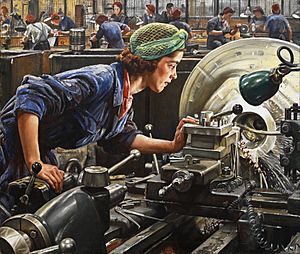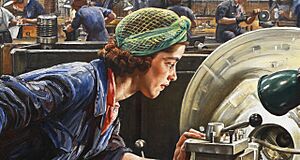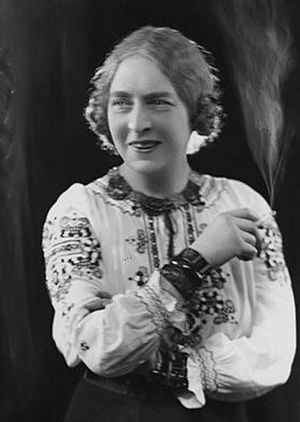Ruby Loftus Screwing a Breech-ring facts for kids
Quick facts for kids Ruby Loftus Screwing a Breech-ring |
|
|---|---|
 |
|
| Artist | Laura Knight |
| Year | 1943 |
| Medium | Oil on canvas |
| Dimensions | 86 cm × 100 cm (34 in × 40 in) |
| Location | The Imperial War Museum Collection |
Ruby Loftus Screwing a Breech-ring is a famous painting from 1943. It was created by the British artist Laura Knight. The painting shows a young woman named Ruby Loftus working in a factory. She is using a large machine called a lathe to make a part for a Bofors anti-aircraft gun. This part is called a breech-ring.
The painting was asked for by the War Artists' Advisory Committee. This group helped record the British war effort during World War II. Ruby Loftus was only 21 years old. She became an expert at making breech-rings in just seven months. Normally, this skill took many years to learn.
The painting was made to show how important women's work was in factories during the war. Most people in the picture are women. Only one man can be seen in the background. When the painting was first shown in 1943, people loved it. It was voted the best picture at the art show. Large posters of the painting were made and put up in factories across the country.
Why This Painting Was Made
Art During Wartime
During World War II, the British government created a group called the War Artists' Advisory Committee (WAAC). This committee was led by Sir Kenneth Clark. Their job was to find artists who could show what the war was like. They wanted to record the war both at home and in other countries.
Laura Knight was one of the artists chosen many times. She had also painted for the Canadian government during the First World War.
Women in Factories
Around 1943, there were some problems in British factories. Women working in war production felt their skills were not fully used. Some people thought factory girls were "low class" or "dirty." Women were also more likely to miss work than men. This was often because they had to take care of children or their homes.
Because there weren't enough women working in factories, the government wanted artists to show factory workers. They hoped this would encourage more women to join the workforce.
Laura Knight's Commission
Laura Knight was asked to paint Ruby Loftus in late 1942. Ruby was described as an "outstanding factory worker." Knight was already working on another painting. She asked for a higher payment for the Ruby Loftus painting. She said it was still much less than she would normally charge.
Knight traveled to Newport, Wales, to paint Ruby. She worked there for three weeks. The painting was finished by the end of March 1943.
About Ruby Loftus
Ruby Loftus and her family moved to South Wales after their home in London was bombed. She started working at the Royal Ordnance Factory in Newport. Before this, she worked in a shop.
In 1943, Ruby was 21 years old. She had no experience with big machines before. But she quickly became very skilled at making breech-rings. This was the hardest job at the factory. If the breech-ring wasn't perfect, the gun could break when fired. This job was usually given to workers with up to nine years of experience.
What the Painting Shows
Ruby at Work
Ruby Loftus Screwing a Breech-ring is a large oil painting. It is one of the biggest single-person paintings from the war commissions. The painting is done in a realist style. This means it looks very much like real life. Some people think it looks like Soviet art that showed workers as heroes.
The picture shows Ruby bending over the lathe. She is cutting the screw of the breech. Her fingers are on the machine. She is very focused on her work. The painting shows Ruby as a young and pretty woman. She has brown curly hair under a green headscarf. She wears paint-splattered overalls and makeup. This shows her feminine side.
Ruby's face is in the middle of the painting. It is lit up by the light shining on the wet metal. This makes her face stand out.
Factory Details
The painting shows Ruby cutting the screw threads. These threads would connect the gun's barrel to its breech. Sparks and water droplets fly off the lathe. Ruby's workspace looks clean and well-organized. The painting shows many technical details. This makes it clear that Ruby was truly an expert at her job.
In the background, you can see the rest of the factory floor. Many women are working at their machines. There is one man, who is likely the foreman. The women's clothes have patriotic colors like red, white, and blue. This painting, along with others from that time, helped show that factory work was often done by women during the war.
Some art experts say Knight's painting style is like a "documentary." It looks as real as a photograph but has a stronger impact. This was similar to many British war movies that showed working-class people in a realistic way.
What Happened Next
Ruby's Life After the War
Ruby Loftus married Lance Corporal John Green in September 1943. She took his last name. After the war, she could have studied engineering. But she decided not to. She moved to Canada with her husband. They settled in a place called Winfield, British Columbia.
In Canada, Ruby worked as an apple packer and at a post office. She also wrote for a local newspaper. In 1962, she visited London to see her portrait at the Imperial War Museum. Laura Knight was with her. Ruby later became ill with multiple sclerosis. Her husband died in 2003. Ruby died in June 2004, at age 83.
In 2015, a new housing area was built where the factory used to be. It was named Loftus Garden Village, after Ruby.
The Painting's Impact
The head of the WAAC, Sir Kenneth Clark, was very happy with Laura Knight's war paintings. He wrote to her that they were a "huge success." Because this painting was so popular, Knight received more factory painting jobs in the 1940s.
In 1945, she painted Switch Works in Birmingham. She also painted scenes at concrete and ball bearing factories. In 1946, she went to Germany. There, she painted The Nuremberg Trial, which showed the war crimes trials.
In 2006, the painting returned to Newport. It was part of a project to collect stories from women who worked at the factory. In 2013 and 2014, the painting was shown at the National Portrait Gallery, London, and other places. Today, the painting is still kept in the Imperial War Museum's collection.
See also
- Canary Girls, British women who worked in munitions
- Women in the workforce
- Women in the World Wars
- Bomb Girls





